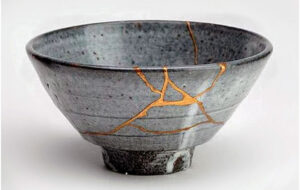Three and a half stories of imperfections and its acceptance
Contents
-
Kintsugi
Recall the most recent occasion when you accidentally dropped a bowl, cup, or vase, causing it to shatter into numerous fragments. Perhaps you responded with frustration, disposing of the broken pieces. However, in Japan, there exists an extraordinary alternative that has been practiced for over five centuries: kintsugi. This ancient art form, literally translating to ‘golden repair’ (‘kin’ meaning golden, and ‘tsugi’ meaning repair), involves utilizing precious metals like liquid gold to join the shattered fragments of pottery, simultaneously enhancing the cracks.
Through kintsugi, each mended piece becomes exceptional, owing to the unpredictable nature of ceramic breakage and the resulting irregular patterns, further emphasized by the use of metallic materials. In the realm of Zen aesthetics, the objective is not to conceal the damage but to render the fault lines beautiful and resilient. The precious veins of gold serve to accentuate the notion that fractures possess their own profound philosophical value.

As a philosophy, kintsugi regards breakage and repair as integral components of an object’s history rather than something to disguise. This Japanese art form teaches us that broken objects are not meant to be concealed but proudly displayed.
In times when adversity appears insurmountable, we often feel shattered. This sentiment may arise from an unfortunate twist of fate, the weight of our own lofty expectations, or a yearning for novelty, for something immediate.
Yet, this tradition imparts the wisdom that resurgence cannot occur without patience. In kintsugi, the drying process assumes a crucial role in achieving success. The resin necessitates weeks, if not months, to solidify, ensuring cohesion and durability.
By learning to appreciate our internal fractures, we attain the tranquility to accept ourselves as we are: broken yet renewed, distinctive, vulnerable, flawed, irreplaceable, and forever evolving.
-
Gabriele Grunewald
 I fondly remember Gabriele Grunewald. Gabriele Ivy Grunewald was an American professional middle-distance runner who competed in distances from 800 meters to 5000 meters. She represented the United States at the 2014 IAAF World Indoor Championships and finished in ninth place in the 3000 meters.
I fondly remember Gabriele Grunewald. Gabriele Ivy Grunewald was an American professional middle-distance runner who competed in distances from 800 meters to 5000 meters. She represented the United States at the 2014 IAAF World Indoor Championships and finished in ninth place in the 3000 meters.
In this photo, You can not miss the thick red scar, carved across Gabriele Grunewald’s midriff as she flies around the track. It is a symbol of the perseverance and pain that she had to face during her fight with cancer. She didn’t hide after this scar. She finally died on 11th June 2019 at the age of 32. A legend in her lifetime!
Krishna’s Vigrah at Dakshineswar Temple
Back in India, we accept imperfections naturally. The story goes that one priest slipped while carrying this image. Krishna’s foot got broken and, since a broken image should not be worshipped, pandits recommended immersing it in the Ganga. The Rani, who built the Dakshineswar Kali Temple was heartbroken because she had become very attached to this image of Krishna. Sri Ramakrishna came to the rescue. He said,” If your son-in-law breaks his leg, will you throw him into the Ganges?” Sri Ramakrishna himself fixed this leg with mud.
-
And the ½ story as promised
 I ran across a bank manager in PNB some 25 years ago. She was so ugly, that I didn’t want to look at her. She was ultra-thin with no hair and then she was trying to cover the scull with a viscous dye all around. I asked for some help and she readily gave me the help. She offered tea and we started talking. I realised that after 15 minutes or so, I really din’t notice that she was ugly. We became good friends for life. Looks are important but more so your performance and attitude. Don’t waste your time hiding behind your imperfections. If you accept yourself. Others will follow the suit.
I ran across a bank manager in PNB some 25 years ago. She was so ugly, that I didn’t want to look at her. She was ultra-thin with no hair and then she was trying to cover the scull with a viscous dye all around. I asked for some help and she readily gave me the help. She offered tea and we started talking. I realised that after 15 minutes or so, I really din’t notice that she was ugly. We became good friends for life. Looks are important but more so your performance and attitude. Don’t waste your time hiding behind your imperfections. If you accept yourself. Others will follow the suit.
Accept your imperfections and the people around you. It is natural.
![]()
I wanted to congratulate you on your determination . It was hard, and you had to put in a lot of effort and time.Very impressive 👍
Thanks, Rajiva. This is my way of giving back to the society!
For me, the half story says more than the other three. For two reasons
1. It is not the story of some celebrity or someone big personally
2. It is an actual experience.
Great! That you liked it.